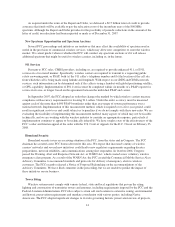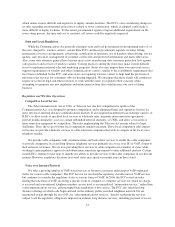Sprint - Nextel 2007 Annual Report Download - page 26
Download and view the complete annual report
Please find page 26 of the 2007 Sprint - Nextel annual report below. You can navigate through the pages in the report by either clicking on the pages listed below, or by using the keyword search tool below to find specific information within the annual report.those services. Successful development and implementation of technology upgrades depend, in part, on the
willingness of third parties to develop new applications in a timely manner. We may not successfully complete
the development and rollout of new technology and related features or services in a timely manner, and they may
not be widely accepted by our customers or may not be profitable, in which case we could not recover our
investment in the technology. Deployment of technology supporting new service offerings may also adversely
affect the performance or reliability of our networks with respect to both the new and existing services. Any
resulting customer dissatisfaction could affect our ability to retain customers and have an adverse effect on our
results of operations and growth prospects.
Our wireless networks provide services utilizing CDMA and iDEN technologies. Wireless subscribers
served by these two technologies represent a smaller portion of global wireless subscribers than the subscribers
served by wireless networks that utilize GSM technology. As a result, our costs with respect to both CDMA and
iDEN network equipment and handsets may continue to be higher than the comparable costs incurred by our
competitors who use GSM technology, which places us at a competitive disadvantage.
The blurring of the traditional dividing lines between long distance, local, wireless, video and Internet
services contribute to increased competition.
The traditional dividing lines between long distance, local, wireless, video and Internet services are
increasingly becoming blurred. Through mergers, joint ventures and various service expansion strategies, major
providers are striving to provide integrated services in many of the markets we serve. This trend is also reflected in
changes in the regulatory environment that have encouraged competition and the offering of integrated services.
We expect competition to intensify across all of our business segments as a result of the entrance of new
competitors or the expansion of services offered by existing competitors, and the rapid development of new
technologies, products and services. We cannot predict which of many possible future technologies, products, or
services will be important to maintain our competitive position or what expenditures we will be required to make
in order to develop and provide these technologies, products or services. To the extent we do not keep pace with
technological advances or fail to timely respond to changes in the competitive environment affecting our
industry, we could lose market share or experience a decline in revenue, cash flows and net income. As a result
of the financial strength and benefits of scale enjoyed by some of our competitors, they may be able to offer
services at lower prices than we can, thereby adversely affecting our revenues, growth and profitability.
If we are unable to meet our future capital needs relating to investment in our networks and other obligations,
it may be necessary for us to curtail, delay or abandon our business growth plans. If we incur significant
additional indebtedness to fund our plans or experience a significant decline in financial performance, our
borrowing costs could increase or our ability to raise additional capital could be limited. A recent downgrade
in our rating could cause us to incur higher interest costs and negatively impact our access to the capital
markets.
We likely will require additional capital to make the capital expenditures necessary to implement our
business plans, including our fourth generation network, to support future growth of our wireless business and to
satisfy our debt service requirements. In addition, we may incur additional debt in the future for a variety of
reasons, including future acquisitions. We may not be able to arrange additional financing to fund our
requirements on terms acceptable to us. Our ability to arrange additional financing will depend on, among other
factors, our ratings, financial performance, general economic conditions and prevailing market conditions. Some
of these factors are beyond our control. One debt rating agency recently downgraded our rating to below
investment grade, and this may cause us to incur higher interest costs and our access to the capital markets could
be negatively impacted. Our access to the commercial paper market may not be available on terms attractive to
us, or at all. Failure to obtain suitable financing when needed could, among other things, result in our inability to
continue to expand our businesses and meet competitive challenges. If we incur significant additional
indebtedness, or if we do not continue to generate sufficient cash from our operations, our ratings could be
adversely affected, which would likely increase our future borrowing costs and could affect our ability to access
capital.
24
























